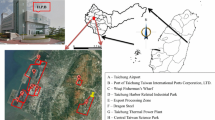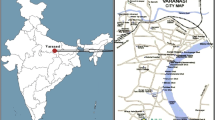Abstract
The development of industry in Beijing, the capital of China, particularly in last decades, has caused severe environmental pollution including particulate matter (PM), dust–haze, and photochemical smog, which has already caused considerable harm to local ecological environment. Thus, in this study, air particle samples were continuously collected in August and December, 2014. And elements (Si, Al, V, Cr, Mn, Fe, Ni, Cu, Zn, Mo, Cd, Ba, Pb and Ti) and ions (\({\text{NO}}_{3}^{-}\), \({\text{SO}}_{4}^{2-}\), F−, Cl−, Na+, K+, Mg2+, Ca2+ and \({\text{NH}}_{4}^{+}\)) were analyzed by inductively coupled plasma mass spectrometer and ion chromatography. According to seasonal changes, discuss the various pollution situations in order to find possible particulate matter sources and then propose appropriate control strategies to local government. The results indicated serious PM and metallic pollution in some sampling days, especially in December. Chemical Mass Balance model revealed central heating activities, road dust and vehicles contribute as main sources, account for 5.84–32.05 % differently to the summer and winter air pollution in 2014.





Similar content being viewed by others
References
Almeida, S. M., Pio, C. A., Freitas, M. C., Reis, M. A., & Trancoso, M. A. (2006). Approaching PM2.5 and PM2.5–10 source apportionment by mass balance analysis, principal component analysis and particle size distribution. Science of the Total Environment, 368(2–3), 663–674.
Awan, M. A., Ahmed, S. H., Aslam, M. R., & Qazi, I. A. (2011). Determination of total suspended particulate matter and heavy metals in ambient air of four cities of Pakistan. Iranica Journal of Energy and Environment, 2(2), 128–132.
Bardouki, H., Liakakou, H., Economou, C., Sciare, J., Smolik, J., Zdimal, V., et al. (2003). Chemical composition of size resolved atmospheric aerosols in the eastern Mediterranean during summer and winter. Atmospheric Environment, 37, 195–208.
BJEPB. (2014). http://www.bjepb.gov.cn/bjepb/323474/331443/331937/333896/396191/index.html. April 16 2014.
Chen, Y. Y., Ebenstein, A., Greenstone, M., & Li, H. B. (2013). Evidence on the impact of sustained exposure to air pollution on life expectancy from China’s Huai river policy. PNAS,. doi:10.1073/pnas.1300018110.
Chen, X., Xia, X. H., & Zhao, Y. (2010). Heavy metal concentrations in roadside soils and correlation with urban traffic in Beijing, China. Journal of Hazard Materials, 181, 640–646.
Deng, W. J., Louieb, P. K. K., Liu, W. K., Bi, X. H., Fu, J. M., & Wong, M. H. (2006). Atmospheric levels and cytotoxicity of PAHs and heavy metalsin TSP and PM2.5 at an electronic waste recycling site in southeast China. Atmospheric Environment, 40, 6945–6955.
Fang, G. C., Chang, C. N., Chu, C. C., Wu, Y. S., Fu, P. P. C., Yang, I. L., et al. (2003). Characterization of particulate, metallic elements of TSP, PM2.5 and PM2.5–10 aerosols at a farm sampling site in Taiwan,Taichung. Science of the Total Environment, 308, 157–166.
Fang, G. C., Wu, Y. S., Huang, S. H., & Rau, J. Y. (2005). Review of atmospheric metallic elements in Asia during 2000–2004. Atmospheric Environment, 39, 3003–3013.
Fu, Joshua S., Streets, David G., Jang, Carey J., et al. (2009). Modeling regional/urban ozone and particulate matter in Beijing, China. Journal of the Air and Waste Management Association, 59(1), 37–44.
Guan, J. J. (2010). Ion composition and acidic research on the fine particulate matters in Shanghai. Thesis of Master Degree of Shanghai University.
Huo, J., Li, P. H., & Han, B. (2011). Character and source analysis of carbonaceous aerosol in PM2.5 during autumn-winter period. Chinese Environment Sciences, 31(12), 1937–1942.
Kelly, Frank J., & Fussell, Julia C. (2015). Air pollution and public health: Emerging hazars and improved understanding of risk. Environmental Geochemistry and Health, 37, 631–649.
Kim, K. H., Mishra, V. K., Kang, C. H., Choi, K. C., Kim, Y. J., & Kim, D. S. (2006). The ionic compositions of fine and coarse particle fractions in the two urban areas of Korea. Journal of Environmental Management, 78, 170–182.
Koçak, M., Mihalopoulos, N., & Kubilay, N. (2007). Chemical composition of the fine and coarse fraction of aerosols in the northeastern Mediterranean. Atmospheric Environment, 41(34), 7351–7368.
Krzyzanowski, M., & Cohen, A. (2008). Update of WHO. Air quality guidelines. Air Quality, Atmosphere and Health, 1, 7–13.
Lee, B. K., & Hieu, N. T. (2011). Seasonal variation and sources of heavy metals in atmospheric aerosols in a residential area of Ulsan, Korea. Aerosol and Air Quality Research, 11, 679–688.
Leiva, G. M. A., Santibañez D. A., Ibarra E. S., et al. (2013). A five-year study of particulate matter (PM2.5) and cerebrovascular diseases. Environmental Pollution 181, 1–6.
Li, P., Xin, J. Y., Wang, Y. S., et al. (2014). Association between particulate matter and its chemical constituents of urban air pollution and daily mortality or morbidity in Beijing city. Environmental Science and Pollution Research, 22(1), 358–368.
Li, Y. P., Zhang, Z. S., Liu, H. F., et al. (2016). Characteristics, sources and health risk assessment of toxic heavy metals in PM2.5 at a megacity of southwest China. Environmental Geochemistry and Health, 38, 353–362.
Pascal, M., Corso, M., & Chanel, O. (2013). Assessing the public health impacts of urban air pollution in 25 European cities, results of the aphekom project. Science of the Total Environment, 449, 390–400.
Serbula, S. M., Miljkovic, D. D., & Kovacevic, R. M. (2012). Assessment of airborne heavy metal pollution using plant parts and topsoil. Ecotoxicology and Environmental Safety, 76, 209–214.
Sun, Y., Pan, Y. P., & Li, X. R. (2011). Chemical composition and mass closure of particulate matter in Beijing, Tianjin and Hebei megacities, Northern China. Environmental Sciences, 9(32), 2732–2740.
Taner, S., Pekey, B., & Pekey, H. (2013). Fine particulate matter in the indoor air of barbeque restaurants, elemental compositions, sources and health risks. Science of the Total Environment, 454–455, 79–87.
Tsai, J. H., Lin, K. H., Chen, C. Y., et al. (2007). Chemical constituents in particulate emissions from an integrated iron and steel facility. Journal of Hazardous Materials, 147(1–2), 111–119.
Turpin, B. J., & Lim, H. J. (2001). Species contribution to PM2.5 concentrations, revising common assumptions for estimating organic mass. Aerosol Science and Technology, 35, 602–610.
Wang, G., Cheng, S., Li, J., et al. (2015). Source apportionment and seasonal variation of PM2.5 carbonaceous aerosol in the Beijing–Tianjin–Hebei region of China. Environmental Monitoring and Assessment, 187(3), 1–13.
Wu, S., Di, Y., Wei, H., et al. (2015). Association of chemical constituents and pollution sources of ambient fine particulate air pollution and biomarkers of oxidative stress associated with atherosclerosis: A panel study among young adults in Beijing, China. Chemosphere, 135, 347–353.
Wu, Y. S., Fang, G. C., Lee, W. J., Lee, J. F., Chang, C. C., & Lee, C. Z. (2007). A review of atmospheric fine particulate matter and its associated trace metal pollutants in Asian countries during the period 1995–2005. Journal of Hazardous Materials, 143(1–2), 511–515.
Yang, F. M., He, K. B., & Ma, Y. L. (2004). Characters of mass balance of the chemical compositions in PM2.5 in Beijing. Environmental Chemistry, 23(3), 327–333. (in Chinese).
Ye, B. M., Ji, X. L., Yang, H. Z., Yao, X. H., Chan, C. K., Cadle, S. H., et al. (2003). Concentration and chemical composition of PM2.5 in Shanghai for a 1 year period. Atmospheric Environment, 37, 499–510.
Zhang, L. L., Wang, C., Dao, X., et al. (2014). Characterization of elements in air particulate matters in heating season in Beijing–Tianjin–Hebei megacities, China. Environmental Monitoring in China, 6(30), 52–61.
Zhang, Y., Zhu, X., & Slanina, S. (2004). Aerosol pollution in some Chinese cities. Pure and Applied Chemistry, 76, 1227–1239.
Zhao, P. S., Dong, F., & He, D. (2013). Characteristics of concentrations and chemical compositions for PM2.5 in the region of Beijing, Tianjin, and Hebei, China. Atmospheric Chemistry and Physics, 13, 4631–4644.
Acknowledgments
This work is partially supported by the “the Fundamental Research Funds for the Central Universities No. 2016JBM048” and “Beijing Key Laboratory of Aqueous Typical Pollutants Control and Water Quality Safeguard”.
Author information
Authors and Affiliations
Corresponding author
Rights and permissions
About this article
Cite this article
Chen, R., Cheng, J., Lv, J. et al. Comparison of chemical compositions in air particulate matter during summer and winter in Beijing, China. Environ Geochem Health 39, 913–921 (2017). https://doi.org/10.1007/s10653-016-9862-9
Received:
Accepted:
Published:
Issue Date:
DOI: https://doi.org/10.1007/s10653-016-9862-9




